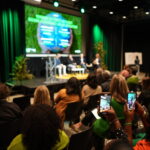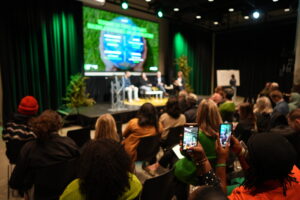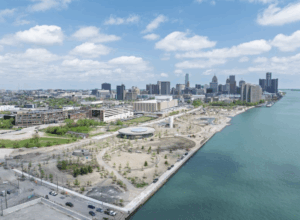If last year offers any hint of what’s to come, more than 700,000 people will head to downtown Detroit to check out what new car models at the NAIAS will be hitting our streets in the new few years. But even before the show opens its doors to the public Cobo Center’s halls will fill with upwards of 5,000 global journalists, and many of the auto industry’s top executives.
Major auto shows, like Detroit’s, have long served as media showcases. At one point, a decade ago, the NAIAS saw automakers unveil 75 new models over three days of previews. This year that count will be down by 40% and most major debuts will take place on a single day, leading some observers to question whether the NAIAS – and auto shows in general – are losing their luster.
“Any time you have 5,000 media show up, it’s still a big event,” counters Rod Alberts, the president of the Detroit Auto Dealers Association, which organizes the NAIAS. Nonetheless, he adds, “It’s time for auto shows to make an adjustment.”
Conversations with more than a dozen automotive event planners and senior public relations executives echo that. They say the days when auto shows were the singularly most important place to unveil new products has passed. More and more models are revealed at private gatherings and non-traditional events – such as the Consumer Electronics Show (CES) held in Las Vegas a week before the NAIAS each year.
That said, auto shows aren’t likely to go away any time soon. The engine behind them is too big. The industry too enthralled. And, they remain wildly popular with the public. Organizers have turned shows like the NAIAS into more than just oversized showrooms, adding entertainment and other draws over the years. And automakers love the fact that this is a salesman dream. According to studies by Forester Research, as many as two-thirds of the consumers who visit the Detroit Auto Show say they plan to buy a new vehicle within the next 12 months.
But some shows are losing the additional prestige of being the backdrop for major product unveilings. That’s happened to once-big European shows in London and Turin, Italy. Here in the U.S., the Chicago Auto Show is a shadow of its former self from a media perspective and “could lose all its previews in a couple years,” warns a ranking Detroit PR chief asking not to be identified by name.
Why the shift?
“As competition increases and new opportunities to attract attention arise – such as social, digital and direct-to-user platforms – auto shows will remain one component of our communications campaigns,” said Dave Reuter, Vice President of Global Communications Operations for Nissan Motor Co. “The difference between fifteen years ago and today is that auto shows are no longer the only method by which to reach your audience.”
Nissan staged a splashy event of its own in Las Vegas last fall to reveal the second-generation Leaf battery-electric vehicle. And its Infiniti brand has frequently introduced new products at the annual Pebble Beach Concours d’Elegance.
Such events have always had a big price tag associated with them, but major auto show event’s top those numbers. Even a minor preview typically starts at well over $1 million, industry lore goes that Ford reportedly spent over $20 million on one especially splashy debut at the Geneva Motor Show around the turn of the millennium.
From a financial standpoint, “by shifting to mega-scale private projects, automakers find they can save a whole lot of money,” says Joe Phillippi, founder of AutoTrends Consulting.
That said, it’s hard to argue against participating in a major show where you can reach as many as 5,000 journalists who’ve flown in from Boston, Beijing and Berlin. And that’s all the more so if a manufacturer has a significant product to reveal.
Both Nissan and its Infiniti brand will have news conference slots at the NAIAS this year, Reuter points out.
But Chevrolet gave reporters a first look at the 2019 Silverado during a one-brand preview in Texas last month and notably will skip doing an auto show news conference at Cobo Center this year.
Honda struck a balance, debuting its new Insight hybrid ahead of the Detroit show as part of a Motor City holiday party last month. But it will stage a major unveiling of the new RDX sport-utility vehicle from its Acura brand at Cobo Center. And Sage Marie, the automaker’s U.S. PR chief, says that Detroit is likely to be one of the last big shows standing from a media standpoint.
“Detroit is still very international, a very big story,” says the Honda exec. “You have a rare concentration of executives – and media from around the world,” so it will remain a centerpiece of Honda’s product launch strategy, he stresses.
For his part, DADA chief Alberts says the Detroit show might actually have gone too far chasing down 75 different product unveilings. “It was overload,” he says in hindsight, difficult for journalists to take in. In turn, that meant some lesser products didn’t get much media attention. A smaller show – there will still be about 45 launches this year – translates into more complete coverage, he believes.

DADA Executive Director Rod Alberts
Alberts gets widespread kudos for turning what had long been a sleepy Detroit Auto Show into the big North American International Auto Show 30 years ago. He’s using that creativity once again to find new ways to increase the event’s relevance.
There’ll actually be more news conferences at the Automobili-D event that overlaps with the traditional product previews this year. Focusing on technological shifts, like the electric and autonomous vehicles expected to transform the auto industry over the coming decade, Automobili-D will run from January 14 to the 18th.
“We’ve really turned this into six shows in one,” says Alberts. That includes the public days and media previews, of course, as well as Automobili-D, a special preview for members of the automotive trade and more. Perhaps the highlight is the big black-tie event that will draw over 15,000 well-coiffed attendees and generate millions for local charities, over $100 Million in fact, since 1976.
There is little doubt that auto shows are in transition. And some once-significant shows are likely to fade away, especially from a media perspective. Let’s hope that Detroit’s organizers remain intent on retaining the event’s relevance by not being wedded to the past. Let innovation rule. This is, ultimately, the most innovative industry is it not?





















